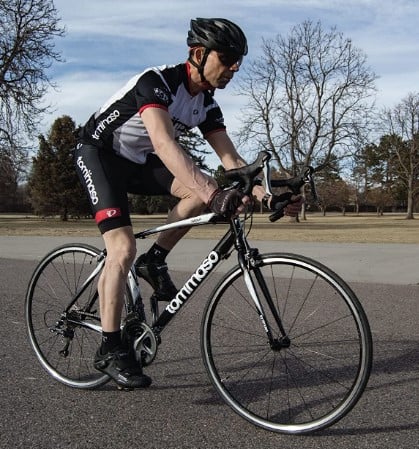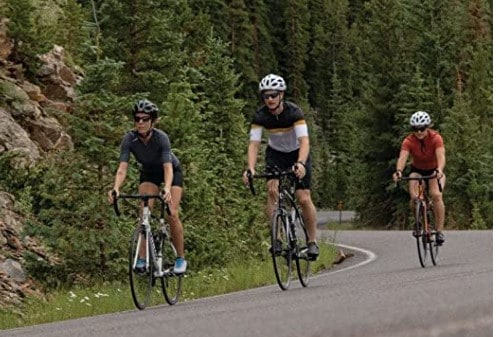When starting out as a beginner cyclist, it’s normal to have myriads of questions as you try to compare yourself with other riders. One common question amongst new riders is; how Fast Do Pro Cyclists Average?
Pro cyclists’ average speeds usually range from 22 mph to 28 mph depending on the type of bike, terrain, and the rider’s fitness. In addition, male cyclists’ average speed tends to be higher than female riders by about ten percent.

On the other hand, an average cyclist can average between 9-15 mph on a flat surface. With good training, beginners rapidly better their average cycling speed with training.
How Fast Do Pro Cyclists Ride?
With the coming of new technology, it is possible to track cyclists throughout a race. Therefore, getting the rider’s average speed on different sections of the route has become easy.
Pro riders put a lot of time and energy into honing their skills for the competition day. Remember, every pro rider was once an amateur at one point.
Generally, as mentioned above, a beginner cyclist can average anywhere between 9 to 15 mph. Notably, there are amateur riders who can average as high as 18 mph.
However, with training, amateurs become professionals, and their average cycling speed improves within a short period.
In elite races such as the Tour de France, pro cyclists usually average 25-26 mph and 22-24 mph on cobblestone.
Notably, on the descent, the average speeds are usually on another level. For example, the fastest ever recorded cycling speed stands at 63.1 mph posted by a German cyclist known as Nils Politt.
Evidently, pro cyclists can ride at mind-boggling speeds at times. If you ever want to turn pro, the best way to learn is to learn from those already ahead of you. All the same, Let’s look at ways through which you can increase your cycling speed.
How Do Pro Cyclists Increase Their Average Speed?
A cyclist’s average cycling speed is relative to many factors such as the type of bike, terrain, weather, and physical fitness.
For example, road bikes with drop bars and slim tires will go faster than a mountain bike or a hybrid bike with chunky tires.

Generally, beginner cyclists will find keeping up with 10 mph for over an hour to be a real struggle. So, what’s the best way to increase your riding speed?
1. Systematic Training
Statistically, riding at 20 mph takes eight times the effort required to ride at 10 mph due to increased air resistance.
Therefore, to improve their average cycling speed, pro riders first tune up their bodies beforehand through training.
Training indoors comes with many benefits since one doesn’t have to worry about the weather and other outdoor challenges. In addition, with turbo trainers, pro cyclists can efficiently work on their cadence in a controlled environment.
2. Brake Less
Another factor that affects how fast a cyclist can average is their braking habits. Actually, professional riders brake less even on a descend since they have developed confidence over time.
Notably, a fast descent will almost always give you more momentum that can get you way up the next climb.
To maintain a higher average speed, pro cyclists attack corners faster, braking later when cornering which helps them maintain higher speed for longs. This skill only comes with practice.
However, always remember to brake while on a straight line before getting into the corner.
At times the bike might roll faster than one is used to and they are tempted to apply the brakes to slow down a bit. This habit can be termed as “comfort braking.”
However, “comfort braking” would slow down a ride, and they would need to pedal harder all the time. in that case, pro cyclist avoid comfort braking at all times.
3. Pumping Up The Tires
The other factor that affects how fast pro cyclists average is tire inflation, especially for road bikes. Perfectly inflated tires have less rolling resistance. Actually, it is advisable to check your tire pressure before every ride.
Most manufacturers usually indicate the recommended pressures on the sidewalls of the tires. Therefore, try to maintain the optimum pressure.

4. Bending And Tucking Their Elbows
The biggest challenge when riding is overcoming wind resistance. Therefore, there is a need to reduce the frontal surface area to slice easily through the wind.
Actually, the best way to reduce air resistance is to lower your body while on the bike. Cyclists should bend and tuck their elbows to assume a streamlined posture.
At the same time, they ride on the drops as opposed to riding on the tops. By doing so, their body assumes a more horizontal position which significantly reduces the aerodynamic drag.
In fact, riding on the drops reduces wind resistance by 20 percent.
5.Riding With Others
Riding with others will definitely challenge one to keep up with the team. This is a sure way that most pro cyclists use to increase their average cycling speed.
In addition, riding tucked behind in a group can save you up to 40% of the effort needed to ride upfront/alone.
However, effective drafting needs thorough practice. As such, this emphasizes the reason it is necessary to ride with others.
6. Build Their Cycling Muscles
To increase one’s cycling speed to a pro-level, you need to gain some strength by building up your riding muscles.
Fortunately, riding regularly can by itself help in gradually increasing one’s average riding speed.
All the same, specific gym training can help speed up the process.
Building cycling muscles will help pro riders to push bigger gears faster than usual. Therefore, they train for both strength and speed.
Actually, pedaling faster saves your knees since you don’t have to pedal hard.

Frequently Asked Questions
1. What Is A Good Average Speed On A Road Bike?
The best average speed for road bikes depends on the rider’s experience. For beginners, 10 mph up to 15 mph is reasonable.
On the other hand, with regular training, you can improve your average cycling speed to about 20 mph.
2. How Fast Should I Cycle To Lose Weight?
Riding at a moderate speed for thirty minutes each time you go out will help in weight loss. Weight loss doesn’t depend on how fast you ride but the intensity.
If you need to burn more calories, you need to cycle for longer durations at moderately intense levels.
3. Can I Start Pro Cycling At 60?
You can start recreational cycling at any age, even past 60. Notably, biking is one of the few exercises that accommodate people of all ages. Actually, it is never too late to stet riding.
All the same, you need to prioritize the quality of your ride because you are more likely to pick injuries as compared to youthful riders.
Actually, a bike such as the sixthreezero Body Ease Women’s Comfort Bike features front suspension and cruiser bike frame geometry for comfort.
4. How Many Miles On A Bike Is Equal To A 1-Mile Walk?
Riding for 10 miles or a bicycle has approximately the same effect as walking or running for one mile.
However, in cycling or walking, the question is not how far you can go but how fast you can cover the distance in question.
Notably, walking for one mile burns 200 calories, but cycling for the same distance burns 53.3 calories.
5. Do Speed Limits Apply To Cyclists?
Speed limits don’t apply to bicycles, and therefore, cyclists cannot be charged for speeding, but they can be charged for careless riding.
In addition, different cities and towns may have bylaws that impose speed limits on bicycles. However, the speed limits listed in the Highway Code are for motorists and not cyclists.
Also Read: How Many Miles Should You Bike In A Day?
Final Word
If you have been wondering how fast pro cyclists average in road races, we hope that you now know. They can get as fast as 30 mph on a flat surface.
On the other hand, if you have long desired to ride as fast as pro cyclists, you need to follow the tips discussed above on how to ride faster.
Most importantly, it’s never too late to start cycling.